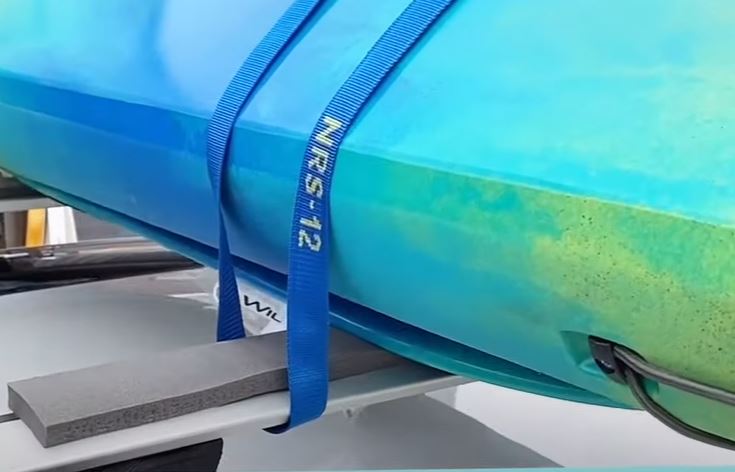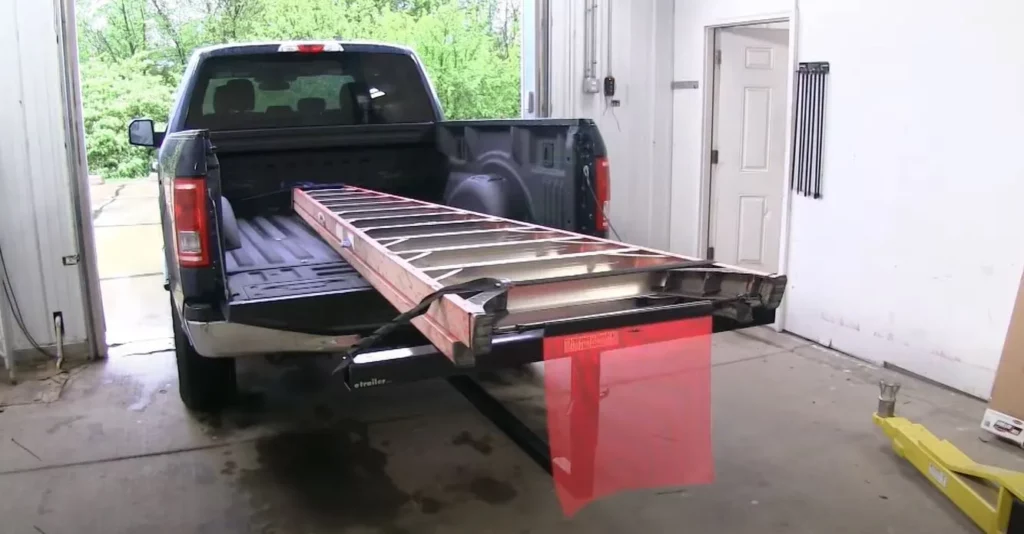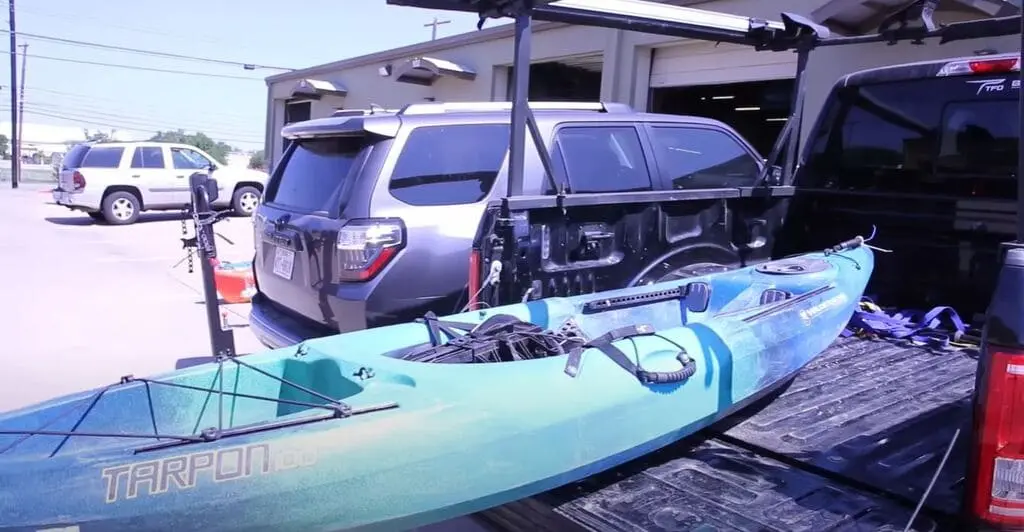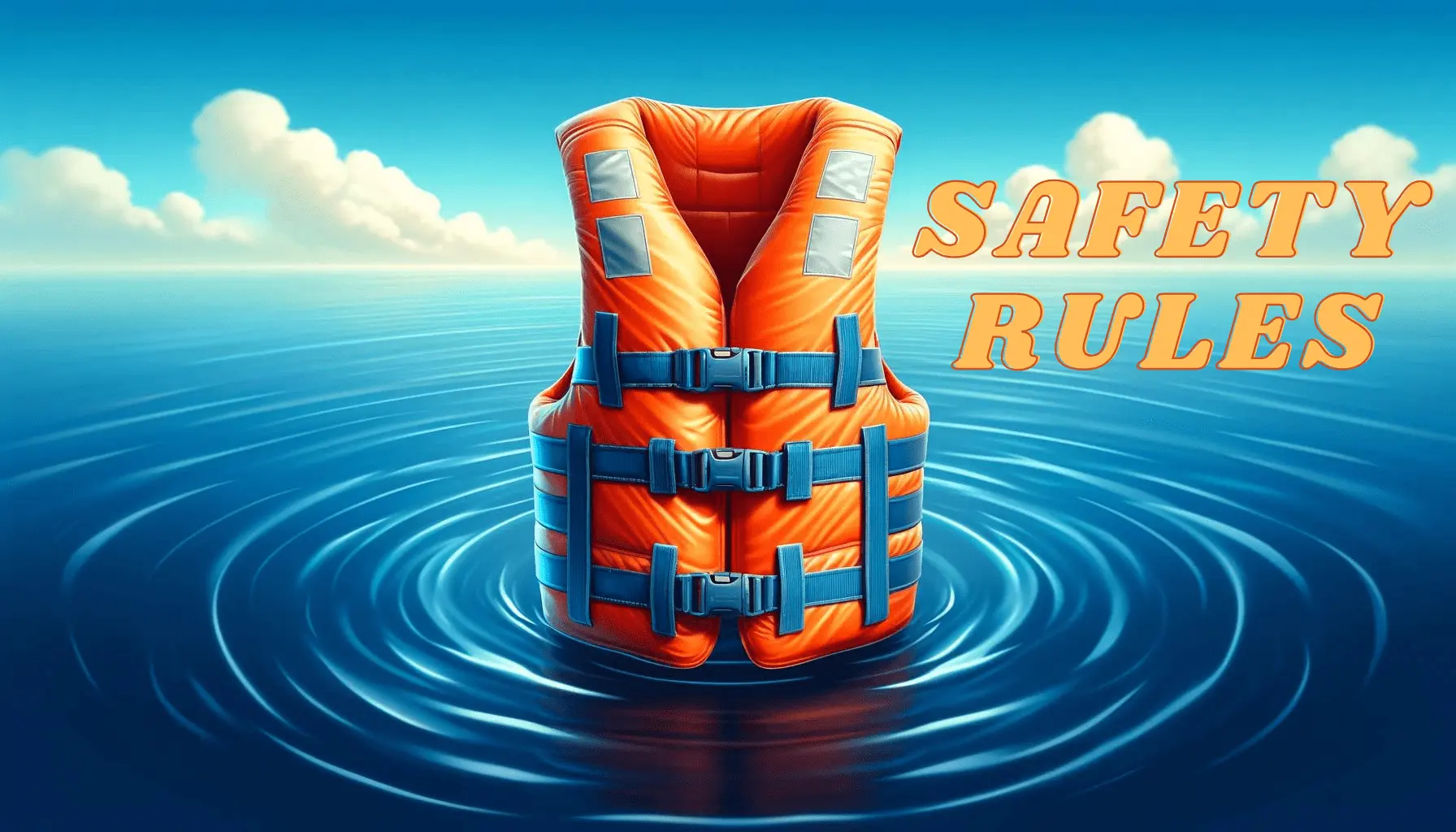Have you ever found yourself puzzled over how to transport your kayak safely and legally atop your truck? With the sun ready to grace the horizon and the water calling, ensuring your vessel arrives intact is just as pivotal as catching that perfect wave. I’m here to demystify the complex world of kayak transportation tips, the nuances of securing a kayak on a truck, and unpack the essentials of kayak overhang safety. You’ve invested a great deal in your kayak, so let’s safeguard that investment together by understanding the critical requirements of truck bed kayak storage and transportation.

Key Takeaways
- Understanding the federal 3-4-4 rule is crucial for transporting kayaks lawfully and safely.
- It’s vital to consult state Department of Transportation guidelines for specific kayak overhang regulations before hitting the road.
- Invest time in securing your kayak properly using the appropriate methods and tools to avoid fines and accidents.
- Ensure that your kayak is visible to other drivers by using flags or LED lights, following federal and state requirements for overhang visibility.
- Adapting to the varying dimensions of kayaks and trucks ensures that transportation is not only practical but also compliant with legal standards.
Understanding the Federal and State Overhang Regulations
As someone who frequently transports my kayak, I’ve learned that adhering to federal and state overhang regulations is crucial. The federal 3-4-4 rule, which stipulates the legal overhang limit for vehicles, plays a significant role. This regulation allows a kayak to overhang 3 feet in front of the vehicle, 4 inches to the side, and 4 feet to the rear. Ensuring that the kayak does not surpass these measurements is paramount to abide by the law and maintain safety on the roads.
Deciphering the 3-4-4 Overhang Rule
Understanding the specifics of the federal 3-4-4 rule can be complex. The rule outputs the maximum length a load, like a kayak, can legally extend beyond the boundaries of your vehicle without requiring additional permits or markings. These dimensions are essential when selecting the best truck racks for kayaks, as they can influence how your kayak is positioned during transport.
State-Specific Overhang Limitations
Equally important is recognizing that individual states may impose their own regulations, which can sometimes differ from the federal standard. For instance, the legal overhang limit might extend to 6 feet in Arizona, while Washington might allow an even greater limit with proper safety markings and permits. Therefore, making informed decisions about how to transport your kayak often means checking in with local Department of Transportation (DOT) resources.
Navigating Legal Requirements with DOT Guidelines
Before embarking on a journey with my kayak in tow, I always consult the recent DOT guidelines, not just for compliance but also to keep updated with any changes that might affect transportation. Especially when considering the best truck racks for kayaks, understanding these guidelines can be the difference between a smooth trip and a run-in with the law.
Securing Your Kayak for Transport: Safety Comes First
When it comes to transporting multiple kayaks on a truck, ensuring that each vessel is properly secured is crucial. As an avid kayaker, I can attest to the range of available kayak transportation accessories designed to make this process safe and manageable. For those with shorter truck beds, the use of a truck bed extender might seem like an appealing solution, granting additional space while keeping in mind its impact on rear overhang. Alternatively, dedicated roof racks specifically for kayaks offer a secure and compliant way of securing a kayak on a roof rack.

When I prepare for a trip, I prioritize the stability of each kayak during transport. Securing each craft involves not only strong tie-down straps but also the right padding. This helps to avoid any damage to both the kayak and the truck. It is essential for paddlers to understand that the combination of a reliable tying method and appropriate protection can significantly mitigate transport risks.
- Pick a suitable truck bed extender or roof rack system designed for kayaks to prevent overhang issues.
- Ensure the use of heavy-duty straps and ratchets to keep your kayak firmly in place.
- Protect the kayak’s surface and the truck with durable padding material.
- Double-check all fixtures before hitting the road to prevent accidental kayak movement or slipping.
By following these steps, you support an unwavering commitment to road safety. Remember, properly securing your kayak serves to protect not just your gear, but also the safety of everyone on the road.
Marking Your Kayak: Flags and Lights for Visibility
When I venture out on a kayaking trip, the ritual of preparing and securing my gear is as important as the paddle itself. A key part of this process is ensuring that the kayak is visible to other road users when it’s being transported. Whether I’m headed to a serene lake or a rushing river, the safety of my kayak on the road – and that of those around me – hinges on the clear visibility of its overhang.
The Importance of Using Warning Flags
During daylight hours, I always use flags to mark my kayak. It’s not just about adhering to the law; it’s about making the overhang visible to other drivers, cutting through the myriad of distractions that confront them. These flags, typically vibrant in orange or red, act as beacons signaling to all that something protrudes beyond the usual confines of my truck.

Nighttime Transportation: LED Lights for Safety
As the sun dips below the horizon and dusk embraces the sky, I switch to LED-based marker lamps to maintain that visibility. Their bright, unwavering light ensures that my kayak’s presence is unmistakable in the nocturnal hours. Each state has its specifications, but I’ve found that adhering to the highest standards of visibility serves me well regardless of where my travels take me.
Multi-Kayak Transport: Individual Markings Matter
Transporting multiple kayaks presents its own set of challenges. Individual markings become even more important. I find that attaching separate flags or lamps to each kayak is the best practice. It creates a clear outline of the entire load, allowing other vehicles a clear understanding of the space my convoy occupies. This attention to kayak overhang safety ensures a hassle-free journey from my garage to the glistening water’s edge.
Ensuring proper marking is part of the responsible kayak transport process. It’s a step I never overlook, for it stands between an uneventful trip and one that could pose risks to myself and others on the open road. And so, as I secure my craft with vigilance, I know that the small effort of attaching a flag or light is an invaluable investment in the safe passage of my cherished vessel.
Kayak Tie-Down Methods: Ensuring Stability on the Road
As I embark on another aquatic adventure, the thought of my kayak swaying precariously on the highway is enough to send shivers down any paddler’s spine. That’s why mastering kayak tie-down methods is essential for any enthusiast. The aim is twofold: securing your kayak on your truck to eliminate the risk of road hazards, while also protecting your prized possession from the wear and tear of travel. Let’s dive into the best practices for strapping down your kayak, the utility of truck bed extenders, and why truck roof racks are an invaluable accessory for kayak transport.
Choosing the Right Tie-Down Straps
Finding the right tie-down strap is akin to selecting the perfect paddle; it’s vital for a successful journey. When I’m securing my kayak on my truck, I opt for heavy-duty straps with a cam buckle to ensure the kayak is snug against the rack or bed extender. This method minimizes movement and the risk of damage during transport. An important tip: always look for straps with protective padding to prevent any friction between the buckle and your kayak’s hull.
The Role of Truck Bed Extenders in Kayak Hauling
When your kayak is longer than your truck bed, it’s time to consider extenders. Truck bed extenders are a functional add-on for extended cargo, acting as a buffer for any extra length. However, be mindful of the legal overhang limits which dictate how far a kayak can extend beyond the bed of your truck. Understanding these restrictions is crucial to avoid fines and ensure truck bed kayak storage is within legal bounds.
Why a Truck Roof Rack Can Be Your Best Bet
Fellow kayakers often ask me if a roof rack is a worthwhile investment, and my answer is a resounding yes. A well-selected truck roof rack is among the best truck racks for kayaks, offering secure placement and easy access. Moreover, with a quality roof rack, transporting multiple kayaks becomes a breeze. The racks are designed to conform to your truck’s specifications, ensuring flawless stability without the risk of overhanging too far on the sides, which can be a common pitfall with improper storage methods.
Ultimately, the peace of mind that comes with knowing your kayak is securely tethered can enhance your entire outdoor experience. From simple day trips to week-long excursions, the way you store and transport your kayak might just be as important as where your adventures take you. Armed with the right equipment and knowledge, we can hit the road with confidence, eager to embrace the serenity and excitement that awaits on the water.
How Far Can a Kayak Hang Out of a Truck
As someone passionate about kayaking and actively engaged in kayak transportation safety, I comprehend the importance of keeping within the permissible protrusion length for kayaks. Federal guidelines set a benchmark, yet each state’s regulations can significantly alter how we transport our kayaks, particularly when handling oversized kayaks.

Understanding and adhering to these guidelines is not just about avoiding fines; it’s about ensuring the safety of fellow drivers and the integrity of our precious cargo. That’s why I always emphasize that checking with the state’s Department of Transportation before setting out is a crucial step in transporting oversized kayaks.
- The federal baseline permits up to 4 feet of rear protrusion
- Front protrusion is limited to 3 feet from the vehicle
However, these lengths can vary depending on where you’re driving.
State-specific guidelines have taught me that there is no one-size-fits-all approach to kayak transportation safety. Instead, we must customize our plans for every trip. And that sometimes means choosing between extending the truck bed or securing the kayak on a roof rack. In my experience, both methods have their advantages as long as we respect the permissible protrusion length.
Whether venturing out to serene lakes or tackling white-water rapids, the journey must begin with secure and legal transportation. Remember, safety is the paddle directing us toward a successful kayaking adventure.
Conclusion
In the realm of adventure sports, kayaking stands out for the unique challenges it presents — not just on the water, but also when it comes to transportation. I have explored the critical importance of adhering to federal and state laws while securing kayaks on trucks for transit. It’s clear that a combination of understanding legal guidelines, using the right equipment, and applying savvy kayak transportation tips can lead to hassle-free travels to your next paddling destination.
Recap: Adhering to Transportation Laws for Kayak Hauling
My pursuit of a safe kayaking adventure means meticulously applying transportation laws in kayak hauling. The 3-4-4 rule has served as my anchor, ensuring that my vessel does not breach permissible overhang limits. Adhering to these regulations not only protects my kayak during transport but also safeguards all road users. As I travel across different regions, I make it a point to stay updated with each state’s unique transportation requirements, thereby embracing the full spectrum of legal compliance.
Key Takeaways for Safe and Legal Kayak Transport
The journey so far has instilled in me a few key takeaways for sturdy and secure transit of my cherished kayak. Selecting robust tie-down straps, employing appropriate overhang markers, and ensuring that my setup is optimized for aerodynamics and visibility are practices I cannot overlook. Securing the kayak for safe travel demands vigilance and the right accessories — a small price to pay for the immeasurable joys of kayaking.
Final Thoughts: Preparing for a Hassle-Free Kayaking Adventure
As I pack my gear and ready my truck once again, the culmination of these insights formulates a sense of preparedness for the adventure that lies ahead. The knowledge I’ve gained and the methods I’ve adopted are testaments to my devotion to this sport and the safety of all who share the road with me. Fully equipped with these kayak transportation tips, I am set to embark on another journey, confident that my kayak will arrive intact and ready for the waters that await.
You might also be interested in reading: How To Transport A Kayak On A Small Car: Find Best Solutions
FAQ
How far can a kayak hang out of a truck safely and legally?
A kayak can hang out up to 4 feet from the rear of the truck and 3 feet from the front according to federal regulations. This is known as the 3-4-4 rule. However, state laws can vary, so it’s important to consult individual state Department of Transportation guidelines to ensure compliance.
What is the federal 3-4-4 rule in regards to kayak overhang?
The federal 3-4-4 rule refers to the allowable limits for any overhanging load on a vehicle. For kayaks, this means they can legally overhang up to 3 feet in front of the truck, 4 inches to the sides, and 4 feet to the rear without requiring additional marking during daylight.
Are there state-specific overhang limitations I need to be aware of?
Yes, individual states may have their own overhang limitations which might deviate from the federal guide. It’s crucial to check with the state’s Department of Transportation where you will be traveling for specific overhang rules and any permit requirements.
Can I use a truck bed extender for transporting my kayak, and what are the benefits?
Yes, a truck bed extender can be used when transporting kayaks that exceed the length of the truck bed. They provide additional support and can help you stay within legal overhang limits by extending the effective length of your truck bed for easier and safer transportation of your kayak.
What are some essential kayak transportation accessories I should consider?
Essential kayak transportation accessories include roof racks that are designed for kayaks, tie-down straps, padding to protect the kayak and truck bed, visibility flags, LED marker lamps for nighttime, and lock systems to secure the kayak to your vehicle.
Why is it important to use flags to mark my kayak when transporting?
Flags are vital for making your overhanging kayak visible to other drivers, especially during daylight hours. They help to alert others to the presence of an extended load, thus enhancing road safety and helping to prevent potential accidents.
What should I keep in mind when transporting kayaks at night?
For nighttime transportation of kayaks, it’s important to use LED-based marker lamps to illuminate the overhang. This helps in maintaining visibility and ensuring safety for both you and other road users. Always ensure these lights are working properly before embarking on your journey.
Should each kayak have its own warning flag when transporting multiple kayaks on a truck?
Yes, when hauling multiple kayaks, it’s recommended that each kayak have its own warning flag to ensure individual kayaks are visible to following drivers. This enhances overall safety on the road.
What tie-down methods should I use to secure my kayak on my truck?
The most reliable tie-down methods include using sturdy straps that can be tightened over and around the kayak without damaging it. For trucks, you can also use truck bed extenders or quality roof racks that best accommodate your kayak’s size and weight, providing you with a secured load during transportation.
Why might a truck roof rack be the best option for transporting my kayak?
A truck roof rack may be the best option if you are transporting multiple kayaks or if your kayak is particularly long. Roof racks specifically designed for kayaks ensure proper fit and can help in avoiding overhang issues. This method also frees up your truck bed space for other gear.
What is the permissible protrusion length for kayaks hanging out of a truck in most states?
Most states adhere to the federal guideline of a permissible 4 feet rear and 3 feet front protrusion. However, given that states can have different regulations, it is crucial to check the specific rules for each state you’ll be traveling in to ensure that you remain within the legal limits.
How can I ensure I am adhering to transportation laws when hauling my kayak?
To ensure you are adhering to transportation laws when hauling your kayak, familiarize yourself with federal and state overhang regulations, use proper tie-down techniques and accessories, and ensure the kayak is appropriately marked with flags or lights for visibility. Always double-check your setup before hitting the road.



